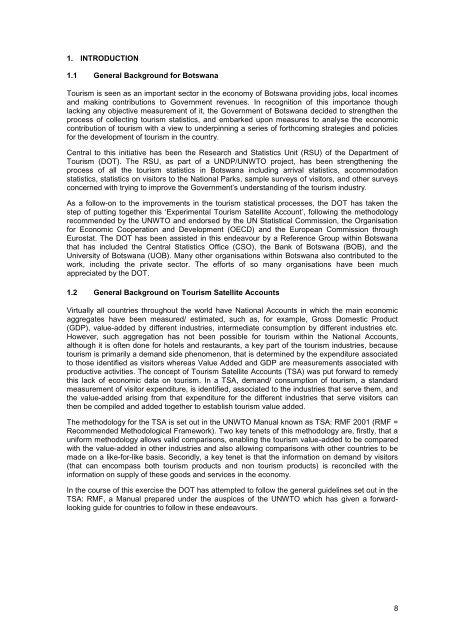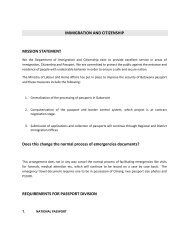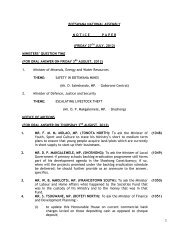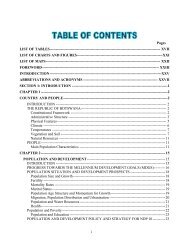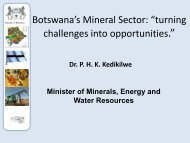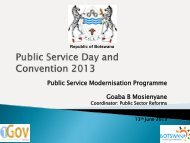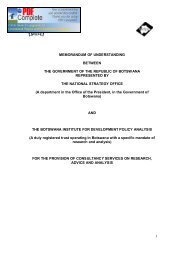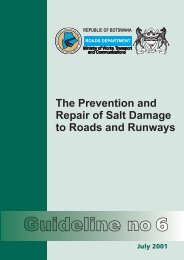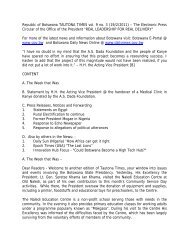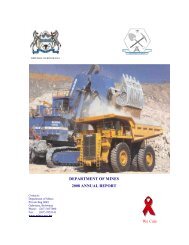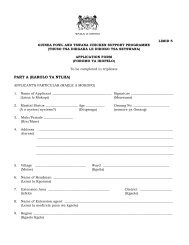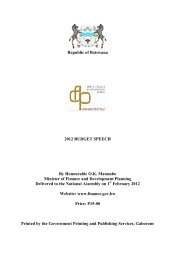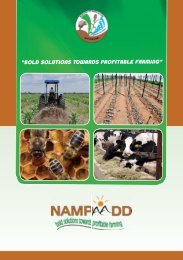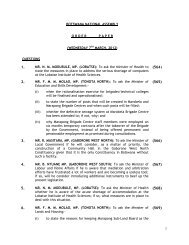Tourism Statistics - Government of Botswana
Tourism Statistics - Government of Botswana
Tourism Statistics - Government of Botswana
Create successful ePaper yourself
Turn your PDF publications into a flip-book with our unique Google optimized e-Paper software.
1. INTRODUCTION<br />
1.1 General Background for <strong>Botswana</strong><br />
<strong>Tourism</strong> is seen as an important sector in the economy <strong>of</strong> <strong>Botswana</strong> providing jobs, local incomes<br />
and making contributions to <strong>Government</strong> revenues. In recognition <strong>of</strong> this importance though<br />
lacking any objective measurement <strong>of</strong> it, the <strong>Government</strong> <strong>of</strong> <strong>Botswana</strong> decided to strengthen the<br />
process <strong>of</strong> collecting tourism statistics, and embarked upon measures to analyse the economic<br />
contribution <strong>of</strong> tourism with a view to underpinning a series <strong>of</strong> forthcoming strategies and policies<br />
for the development <strong>of</strong> tourism in the country.<br />
Central to this initiative has been the Research and <strong>Statistics</strong> Unit (RSU) <strong>of</strong> the Department <strong>of</strong><br />
<strong>Tourism</strong> (DOT). The RSU, as part <strong>of</strong> a UNDP/UNWTO project, has been strengthening the<br />
process <strong>of</strong> all the tourism statistics in <strong>Botswana</strong> including arrival statistics, accommodation<br />
statistics, statistics on visitors to the National Parks, sample surveys <strong>of</strong> visitors, and other surveys<br />
concerned with trying to improve the <strong>Government</strong>‟s understanding <strong>of</strong> the tourism industry.<br />
As a follow-on to the improvements in the tourism statistical processes, the DOT has taken the<br />
step <strong>of</strong> putting together this „Experimental <strong>Tourism</strong> Satellite Account‟, following the methodology<br />
recommended by the UNWTO and endorsed by the UN Statistical Commission, the Organisation<br />
for Economic Cooperation and Development (OECD) and the European Commission through<br />
Eurostat. The DOT has been assisted in this endeavour by a Reference Group within <strong>Botswana</strong><br />
that has included the Central <strong>Statistics</strong> Office (CSO), the Bank <strong>of</strong> <strong>Botswana</strong> (BOB), and the<br />
University <strong>of</strong> <strong>Botswana</strong> (UOB). Many other organisations within <strong>Botswana</strong> also contributed to the<br />
work, including the private sector. The efforts <strong>of</strong> so many organisations have been much<br />
appreciated by the DOT.<br />
1.2 General Background on <strong>Tourism</strong> Satellite Accounts<br />
Virtually all countries throughout the world have National Accounts in which the main economic<br />
aggregates have been measured/ estimated, such as, for example, Gross Domestic Product<br />
(GDP), value-added by different industries, intermediate consumption by different industries etc.<br />
However, such aggregation has not been possible for tourism within the National Accounts,<br />
although it is <strong>of</strong>ten done for hotels and restaurants, a key part <strong>of</strong> the tourism industries, because<br />
tourism is primarily a demand side phenomenon, that is determined by the expenditure associated<br />
to those identified as visitors whereas Value Added and GDP are measurements associated with<br />
productive activities. The concept <strong>of</strong> <strong>Tourism</strong> Satellite Accounts (TSA) was put forward to remedy<br />
this lack <strong>of</strong> economic data on tourism. In a TSA, demand/ consumption <strong>of</strong> tourism, a standard<br />
measurement <strong>of</strong> visitor expenditure, is identified, associated to the industries that serve them, and<br />
the value-added arising from that expenditure for the different industries that serve visitors can<br />
then be compiled and added together to establish tourism value added.<br />
The methodology for the TSA is set out in the UNWTO Manual known as TSA: RMF 2001 (RMF =<br />
Recommended Methodological Framework). Two key tenets <strong>of</strong> this methodology are, firstly, that a<br />
uniform methodology allows valid comparisons, enabling the tourism value-added to be compared<br />
with the value-added in other industries and also allowing comparisons with other countries to be<br />
made on a like-for-like basis. Secondly, a key tenet is that the information on demand by visitors<br />
(that can encompass both tourism products and non tourism products) is reconciled with the<br />
information on supply <strong>of</strong> these goods and services in the economy.<br />
In the course <strong>of</strong> this exercise the DOT has attempted to follow the general guidelines set out in the<br />
TSA: RMF, a Manual prepared under the auspices <strong>of</strong> the UNWTO which has given a forwardlooking<br />
guide for countries to follow in these endeavours.<br />
8


